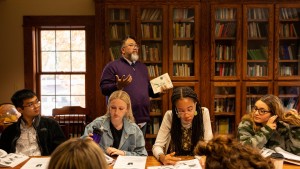As Kenyon’s newest Richard L. Thomas Professor of Creative Writing, Ira Sukrungruang is tasked with invigorating the literary life of the College and helping to shape its creative writing curriculum. Sukrungruang sat with one of his academic advisees, Paola Liendo ’20, an English major from Laredo, Texas, for a conversation about his teaching philosophy, inclusive literature and the future of creative writing at Kenyon.
You’ve written three nonfiction books, a short story collection and a poetry collection, and you’ve been the co-editor of two anthologies on the topic of obesity. You’re also one of the founding editors of “Sweet: A Literary Confection.” Memoirist, essayist, poet, fiction writer. You clearly don’t limit your forms of expression. Across genres, do you feel there are any commonalities in your writing interests? What are you prioritizing right now? And are there any core writing values or subjects that you always come back to?
I think writers are obsessive creatures. I obsess about body image. I obsess about immigrant narratives. I obsess about race. And right now, I obsess about fatherhood. So, I think for me to deal with these many obsessions, I have to try my hand at different forms of writing. That’s the appeal for me. One of the things that I love about language, and that I love about creative writing, is that there are infinite ways to write, to shape a sentence. And one of those ways is, for example, “What does the body look like in a poem?” “What does the body look like in an essay, or in a short story?” I’m constantly challenging myself to find different and more unique ways of telling stories that never leave me.
One of your areas of expertise is “inclusive literature.” Can you expand on what that means?
I’m constantly aware of the texts my students are reading. I want the texts I ask my students to read to be a reflection of our culture — and our culture is multicultural. Our culture deals with varying ideas of sexuality. Our culture is composed of writers who are from different socioeconomic classes. So, when I say “inclusive,” I’m looking at a literature that is more welcoming of all voices, and I’m looking to facilitate a space in the classroom where we can discuss these issues that are very current and important in our culture. The creative writing classroom is the ideal place to talk about these things, because literature never provides a black and white answer. It presents us with gray areas. It presents us with personal experience. Consider, for example, race as it’s portrayed in the media. It’s a very different type of rhetoric being used there, whereas literature allows for subtlety, nuance and more questions than answers. Right? So, what’s created in that is a dialogic exchange; instead of talking at each other, we begin talking with each other. And that’s what I mean by “inclusive literature.”
Part of the problem in our culture, I think, is that we’ve forgotten how to talk to each other. We are also more afraid of being wrong or vulnerable, and we’re fiercely protective of what we think is right, without hearing other voices. For me, the classroom, the things I teach, the things I talk about, are ways to expand rather than contract discussions.
What’s the most interesting lesson you’ve learned from a student?
I’m always reminded of the importance of literature when I see my students get so wrapped up and involved in language and story — so much so that it occupies them. It takes over. And I sometimes forget that because I teach every day. I’ve been teaching for 20 years. I go into the classroom, I do my thing, I come out. But then, there are little reminders, you know? I had one recently, in class, when we were talking about race. I had a student who was just really affected by it, and suddenly — it’s not a class anymore. This is a place to talk. This is a place where my students can feel empowered to share their vulnerabilities about the world they live in, and how the world breaks their heart.
I need those reminders. There’s a safety about being here in academia, and that safety seems, at times, like a way to separate the classroom from the outside world. But the outside world is always happening, and is always having an effect on my students, and on myself. My students remind me that we are all part of this together, and that one person’s suffering is everyone’s suffering. I think a lot of times we wall up or don’t want to talk about these issues of race or disability or difference because we fear conflict. We fear what someone might say. But by doing that, we ignore the thing that we really need to address. We keep talking about equality. But I think that we should think beyond equality. We should want more than equality. That’s the thing: This one class I’m teaching right now, this amazing bunch of bright sophomores and freshmen, is a reminder that students want. They’re so eager. And so I think that that’s the biggest lesson and reminder that I carry with me all the time.
